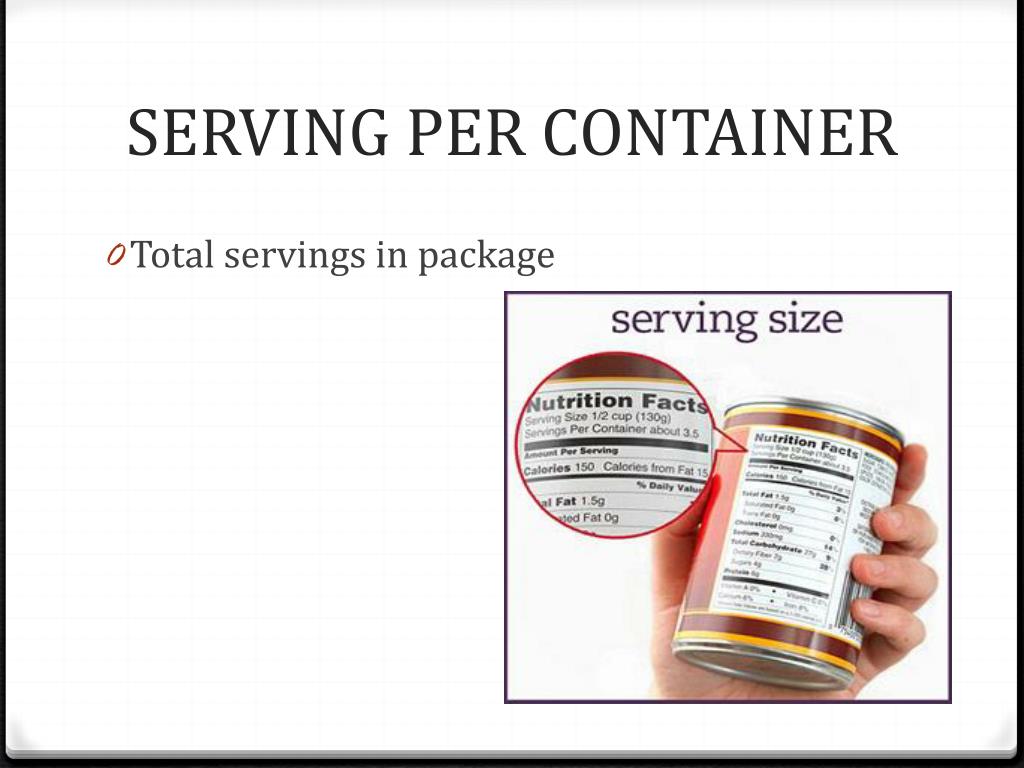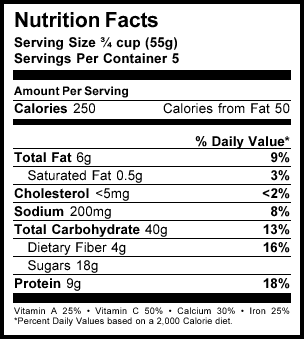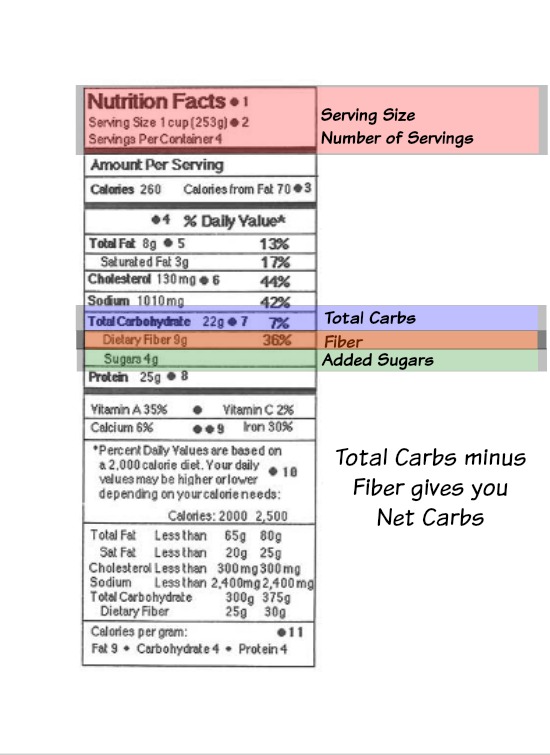44 reading carbs on food labels
Low Carb Guide to Understanding Nutrition Labels - Virta Health According to labeling laws in the U.S., if a food contains less than 0.5g of trans fat per serving, the label can say 0g, so be sure to read the list of ingredients. You can spot trans fats by the words "hydrogenated" or "partially hydrogenated" with oils. Sugar-free or Low-carb: Don't be fooled by clever packaging and slick marketing. How To Read Food and Beverage Labels | National Institute on Aging 24/02/2022 · Reading food labels can help you make smart food choices. Learn how to read and understand the product date, ingredient list, and Nutrition Facts label. ... calories, and carbs as the regular version of the food. Multigrain. This sounds healthy but only means that a product contains more than one type of grain. Unless the product is marked as ...
How to Use the Nutrition Facts Label - Diet Doctor Very simply, after calculating net carbs, take a look at the grams of fat and protein on the nutrition facts label. There are about 9 grams of net carbs in this KIND bar. Let's say you are comparing it to another snack with 8 to 10 grams of net carbs. They are close. How do you choose?

Reading carbs on food labels
How to Read Carbohydrates on Nutrition Labels - Optimal Health The top carbohydrates row is the total amount of carbs present. Made up of all the sugars, dietary fibre and starch, which is the remaining amount after the sugar and fibre. So in the above muesli label we have 51.8g of carbs per 100g. 12.7g is sugar 7.9g is fibre Which means that 31.2g is starch (51.8 - 12.7 - 7.9) Reading Food Labels and Avoiding Hidden Carbs - Kiss My Keto Blog Foods are made to be purposefully addictive with the addition of a variety of substances which are laughably called "repeat appeal" agents in the food industry. Some of the substances routinely added to our food are neurotoxic, meaning they damage the brain, and are more addictive than cocaine! How to Understand and Use the Nutrition Facts Label | FDA It can tell you if a serving of food is high or low in a nutrient and whether a serving of the food contributes a lot, or a little, to your daily diet for each nutrient. Note: some nutrients on the...
Reading carbs on food labels. How to Read Food Labels | mySugr Before reading the rest of the label, look at the serving size. The rest of the information — such as carbs, calories, sugars, fiber, and more — will be based on the serving size that's listed. Eating more than a serving size means you'll get more carbs, sugars, and calories than what's listed. Looking at the serving size also helps ... 【How-to】How to read food labels - Howto.org Reading Food Labels. Step 1: Check serving sizes and calories per serving. … Step 2: Check the fat content. … Step 3: Check the cholesterol content. … Step 4: Check the sodium (salt) … Step 5: Check the total carbohydrates and sugar. … Step 6: Check the fiber. … You can also check the percent DV (Daily Value) Reading Food Labels | ADA - American Diabetes Association Reading Food Labels. Understanding Food Labels. It’s time to decode those food claims. Trying to figure out nutritional information on labels and packaging isn’t easy. The good news is that we can help. ... From carb-free to low-carb, to whole … How To Read Nutrition Labels (Like a Pro) - Ditch The Carbs Firstly you need to understand the difference between total and net carbs. TOTAL CARBS = sugars + starches +fibre NET CARBS = total carbs - fibre Carbohydrates will be on the nutrition label are often broken down into carbohydrates, sugars, starch, and fiber. However, each brand may display its nutritional contents differently.
How to Read Food Labels & Count Carbs | Allulose Allulose Labeling. Allulose is a form of sugar, so it will count toward total sugar and carbohydrate (CHO) grams on food and beverage labels, even though it is not metabolized in the body and does not contribute calories to the diet. Products made with allulose will have fewer calories compared to a full-calorie counterpart, but total ... Making Sense of Food Labels | ADA Trying to figure out nutritional information on labels and packaging isn’t easy. The good news is that we can help. These food labels are especially helpful if you use carb counting to plan your meals! If you get tripped up on food content claims, you’re not alone. Fat free vs. low fat vs. reduced fat. Low cholesterol vs. reduced cholesterol. Understanding Food Nutrition Labels | American Heart Association Remember that the information shown in the label is based on a diet of 2,000 calories a day. You may need less or more than 2,000 calories depending upon your age, gender, activity level, and whether you're trying to lose, gain or maintain your weight. When the Nutrition Facts label says a food contains "0 g" of trans fat, but includes ... Reading labels | Diabetes UK Always look at the 'total carbohydrate' on the label when carb counting. This will make sure you are counting both the complex (starchy) and simple (sugary) carbs in your food. Both will raise your blood glucose (blood sugar) levels, and need to be matched with insulin.
PDF Read the Food Label for Carbohydrates - NHLBI, NIH Read the Food Label for Carbohydrates Food labels help you choose foods that are lower in calories and in carbohydrates and sweeteners. Here is a food label for a 12-ounce regular soda. The label provides lots of useful information. 1. Serving Size and Number of Servings The serving size is 12 ounces. There's 1 serving in this container. 2. How to Read Carbohydrates on Food Labels - GlycoLeap When learning how to read carbohydrates on food labels, always remember that 1 serving of carbohydrate is equal to 15 g of carbohydrates. If you want to have a snack, it is recommended to eat no more than 1 to 2 servings of carbohydrates in one sitting. That would be around 15 to 30 g of carbohydrates. Snack = 15 - 30 g of carbohydrate This Is How to Read a Nutrition Facts Label on the Keto Diet Each nutrient listed on the label refers to the amount of that label contained in one serving, which is usually not the entire package. For instance, if "Total Carbohydrates" are listed as 10 grams (10 g), that's accurate for one serving. Reading Food Labels | ADA - American Diabetes Association The Nutrition Facts labels on foods are really the key to making the best choices. We'll cover the basics so that these labels make shopping easier for you. Get started Understanding Carbs You've heard it all. From carb-free to low-carb, to whole and empty carbs, it's hard to know what it all means. Learn more Food & Blood Sugar

The 61 names of sugar – Read the food labels for hidden sugar | Reading food labels, Food labels ...
20 Must-Read Books About Health and Food | Eat This Not That 30/06/2021 · This book gives you the 4-1-1 on how to lose 10 pounds and ultimately become a healthier you. It Starts With Food is better described as an action plan rather than a novel. Between the pages, you will find the Whole30 program, which is a sustainable "30-day nutritional reset" that will enable you to break those pesky unhealthy habits and rid yourself of health …
Reading and Understanding Food Labels and Nutrition Info - Beaumont Health Carbohydrates are the main source of energy during most physical activity. Carbohydrates should comprise 50-75 percent of your calories, or about 200-500 grams per day depending on your caloric requirement. Fiber may play as much of a role in disease prevention as fat. Aim for at least 30 grams per day.
How to Read a Food Label to Make Sure It's Keto in 3 Easy Steps How to calculate net carbs Subtract Dietary Fiber and Sugar Alcohols (if any) from the Total Carbohydrate. *Total Carbohydrate minus Dietary Fiber, minus Sugar Alcohol (if any) = Net Carbs Total Carbohydrate ( 4 grams) - Dietary Fiber ( 1 gram) = 3 gram s Net Carbs
How To Read Food and Beverage Labels | National Institute on Aging At the top of the Nutrition Facts label, you will find the total number of servings in the container and the food or beverage's serving size. The serving size on the label is based on the amount of food that people may typically eat at one time and is not a recommendation of how much to eat. Read more about serving and portion sizes.
How To Read Labels In 3 Easy Steps - Remake My Plate Step 2 - How to read food labels - Check Out Carbohydrates Total carbs (highlighted in blue): this shows how many grams of carbs in every form (sugars, fiber and starches) is found in the food item. It includes those sugars, starches and fiber that are naturally occurring in the food item as well as those that have been added in.
Learning To Read Labels :: Diabetes Education Online On a nutrition food label, subtract the fiber from the total carbohydrate amount. When you read food labels, the grams of sugar are already included in the total carbohydrate amount, so you do not need to count this sugar amount separately. The grams of sugar listed include both natural sugars, from fruit or milk, and added sugars.
Reading food labels: Tips if you have diabetes - Mayo Clinic Know what counts as a free food Just as food labels can help you avoid certain foods, food labels can also serve as your guide to free foods. A free food is one with: Fewer than 20 calories a serving Less than 5 grams of carbohydrates a serving Do the math Pay attention to serving sizes.

The Ultimate Guide to Reading Food Labels in Japan | Surviving in Japan: (without much Japanese)
How To Read Food Labels - 10 Tips | Pritikin Program For Eating Right These 10 tips for how to read food labels are all about helping you shed excess weight, take good care of your heart, and live well. For Questions & Reservations Call us at (888) 254-1462. ... Most had more carbs, sugars, and salt than their labels claimed. During your first few trips to the market, give yourself extra time to evaluate products.






Post a Comment for "44 reading carbs on food labels"